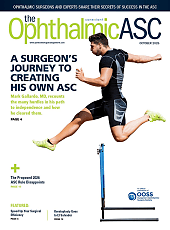Dry eye disease (DED) affects between 5% and 50% of individuals worldwide.1 When its negative impacts on the ocular surface begin to affect patient quality of life, contributing to decreased daily function like reading and driving,1-3 patients tend to seek out care.
For many years, there was a gap in effective treatments for DED and ocular surface disease (OSD). The landscape has evolved recently with the approval of several new therapeutics, and there are now more treatments than ever before. Although this is great news for patients, having so many available options for the treatment of DED introduces a level of complexity. Clinicians must understand the available treatments and know how to select the option that best meets an individual patient’s needs.
Heightened Awareness
Before 2003, the use of an anti-inflammatory to treat DED was nearly unheard of. However, within just a few years of the Food and Drug Administration’s (FDA) approval of cyclosporine ophthalmic emulsion 0.05% (Restasis; AbbVie), an immunomodulator for increasing tear production, the consensus among the ophthalmic community changed, and anti-inflammatory therapy became a cornerstone of DED management.
The development of the Ocular Surface Disease Index (OSDI) in 2005 heightened awareness of OSD. As a result, the perceived incidence and prevalence of DED increased dramatically. Between 2005 and 2012, reported cases of DED tripled.4 While external factors like increased screen time contributed to the surge in DED volume, other factors played larger roles:Clinicians became better at screening for the signs and symptoms of DED, and advanced diagnostic tools, such as tear osmolarity testing and MMP-9 screening, were introduced.
Today, a comprehensive approach to DED management is crucial to not only provide patients with lasting relief from symptoms, but also to prepare the ocular surface for cataract and refractive surgeries. Research has shown that a healthy ocular surface is crucial to maximizing postoperative outcomes.5 Clinical experience dictates that a stepwise approach to DED management is best, starting with a simple treatment like preservative-free artificial tears to provide symptomatic relief and lubricate the eye, and escalating to interventions such as punctal plugs, pharmacology, amniotic membrane, autologous serum tears, and intense pulsed light therapy, as needed. The last 2 are typically reserved for patients who have failed traditional therapies.
An Expanded Landscape
In the therapeutics space, treatment options have expanded significantly since the approval of Restasis. Today’s choices have varying indications and mechanisms of action.
Two older treatments with a similar mechanism of action to Restasis are cyclosporine ophthalmic solution 0.09% (Cequa; Sun Ophthalmics) and lifitegrast ophthalmic solution 5% (Xiidra; Bausch + Lomb). The former is a calcineurin inhibitor immunosuppressant with improved penetration indicated for increasing tear production, and the latter is an LFA-1 antagonist that reduces inflammation and improves OSD symptoms. Common adverse events with these pharmacologic agents include mild-to-moderate ocular burning; instillation-site pain or irritation; eye redness; watery eyes; foreign body sensation; visual disturbance/blurring; decreased visual acuity; dysgeusia; conjunctival hyperemia; and eye pain.6-8
A 2022 study comparing the use of Restasis, Cequa, and Xiidra showed that, for the treatment of chronic DED, patients were most likely to continue Cequa use.9 A generic formulation, cyclosporine ophthalmic emulsion 0.05% (Mylan Pharmaceuticals), is also available to treat ocular inflammation due to keratoconjunctivitis sicca.
In 2023, the FDA approved perfluorohexyloctane (Miebo; Bausch + Lomb), a semifluorinated alkane10,11 that does not target inflammation. According to the manufacturer, Miebo forms a monolayer at the air-tear interface to restrict tear evaporation and mimic key functions of natural meibum. It may be used alongside a topical immunomodulator when ocular surface inflammation is present.
Another of the newer pharmacologic treatments for the signs and symptoms of DED is cyclosporine ophthalmic solution 0.1% dissolved in a semifluorinated alkane (Vevye; Harrow). It is the first and only cyclosporine approved for the treatment of both the signs and symptoms of DED. In my experience, patients feel immediate relief, and, unlike previous cyclosporine formulations that caused burning or irritation, the neutral pH of Vevye makes it comfortable on instillation. Perfluorobutylpentane, a semifluorinated alkane vehicle in Vevye, allows the formulation to spread evenly over the ocular surface with a longer residual time and an increased penetration of cyclosporine.12 Alone, it has been shown to promote corneal healing in as little as 15 days, with most patients (99.8%) reporting mild to no stinging and burning on instillation.13
For patients who need rapid symptom relief and inflammation control, loteprednol etabonate ophthalmic suspension 0.25% (Eysuvis; Alcon) or Flarex ophthalmic solution (Harrow Health) are excellent options. These short-term ocular corticosteroids, dosed 4 times daily for 2 weeks, are an excellent option for managing DED flareups.
Novel Medications
An alternative to drops, varenicline solution 0.03% (Tyrvaya; Viatris) is an intranasal spray that may be used to treat the signs and symptoms of DED. The preservative-free, water-soluble spray targets tear production via neurostimulation and has been shown to increase Schirmer scores by more than 10 mm in about 50% of patients.14 It diffuses quickly across the nasal mucosa and binds with cholinergic receptors on the trigeminal nerve within the nasal cavity to simulate lacrimal function and help produce basal tears. Tyrvaya may be a good option for patients who have difficulty instilling drops as well as those who undergo thermal expression. Patients should be advised of side effects that may include sneezing, coughing, and throat irritation.
Lotilaner ophthalmic solution 0.25% (Xdemvy; Tarsus Pharmaceuticals) has a unique position in the OSD treatment armamentarium. Approved for the treatment of Demodex blepharitis (DB), a 6-week, twice-a-day dosing of Xdemvy has been shown to significantly reduce the presence of collarettes—a waxy buildup of mite waste forming around the base of the eyelashes and the telltale sign of DB.15 A study found that 85% of patients treated with Xdemvy had less than 10 collarettes after the trial, and 60% had zero. It is a great option for patients with OSD and DB to fight inflammation and even improve meibomian gland function.
The upcoming launch of 2 novel medications—Acoltremon (Alcon), a topical agonist of transient receptor potential melastatin 8 (TRPM8), and Reproxalap (AbbVie), a reactive aldehyde species modulator—further underscores the rapid evolution of treatment options. While this expanding arsenal gives us more tools to manage OSD, it also introduces complexity in selecting the most appropriate therapy for each patient.
When a new drug enters the market with a novel mechanism of action, it initially generates significant interest. In clinical experience, however, mechanism of action alone rarely sustains long-term prescribing habits. The true driving factor is how the therapy addresses real-world challenges and pain points encountered in daily practice.
Perhaps the biggest pain point is the 20/20 unhappy patient. In one study, more than half of patients with DED and 20/20 visual acuity reported moderate to severe blurry vision.16 In these cases, I find that treatment with a pharmacologic agent such as Vevye is the best way to progress patients toward 20/happy. It reduces inflammation, increases tear production, and repairs corneal surface damage.17 A study of Vevye showed clinically meaningful and statistically significant improvement in total corneal fluorescein staining by day 15 compared to perfluorobutylpentane.18 Additionally, many patients typically report a silky feeling upon instillation. While the cyclosporine may take some time to work, most patients appreciate the silky feel of the vehicle.
Other common pain points include: red eyes that do not respond to over-the-counter drops; nighttime driving difficulties, such as debilitating glare and halos; and patients discontinuing treatment due to side effects or cost.
For a treatment to be successful, patients must adhere to their regimens. I always counsel patients that dry eye is a disease, just like high blood pressure or high cholesterol. We don’t stop taking our medications for these disorders when we feel better. We must use therapies like Vevye chronically to maintain the health of the ocular surface and prevent future problems.
Moving Forward
The future of OSD treatment lies in continued innovation in drug development as well as diagnostic precision, treatment algorithms, and patient education. With myriad therapies bringing new mechanisms of action and new delivery methods (see “Pipeline Treatments for Ocular Surface Disease,”p.14), our challenge as clinicians is to determine which treatments benefit our patients and our practices in a meaningful way. OM
References
1. Stapleton F, Alves M, Bunya VY, et al. TFOS DEWS II Epidemiology Report. Ocul Surf. 2017 Jul;15(3):334-365. doi: 10.1016/j.jtos.2017.05.003. Epub 2017 Jul 20.
2. Trattler W, Karpecki P, Rapoport Y, et al. The Prevalence of Demodex Blepharitis in US Eye Care Clinic Patients as Determined by Collarettes: A Pathognomonic Sign. Clin Ophthalmol. 2022;16:1153-1164. Published 2022 Apr 15. doi:10.2147/OPTH.S354692
3. Rhee MK, Yeu E, Barnett M, et al. Demodex Blepharitis: A Comprehensive Review of the Disease, Current Management, and Emerging Therapies. Eye Contact Lens. 2023;49(8):311-318. doi:10.1097/ICL.0000000000001003
4. Farrand KF, Fridman M, Stillman IO, Schaumberg DA. Prevalence of diagnosed dry eye disease in the United States among adults aged 18 years and older. Am J Ophthalmol. 2017;182:90-98. doi:10.1016/j.ajo.2017.06.033
5. Schechter B, Mah F. Optimization of the ocular surface through treatment of ocular surface disease before ophthalmic surgery: a narrative review. Ophthalmol Ther. 2022;11(3):1001-1015. doi:10.1007/s40123-022-00505-y
6. Restasis prescribing information. Accessed March 3, 2025. https://media.allergan.com/actavis/actavis/media/allergan-pdf-documents/product-prescribing/Combined-Restasis-and-MultiDose-PI_8-3-17.pdf
7. CEQUA [package insert]. Cranbury, NJ: Sun Pharmaceutical Industries, Inc.; 2022.
8. Xiidra prescribing information. Accessed March 3, 2025. www.bausch.com/globalassets/pdf/packageinserts/pharma/xiidra-prescribing-information.pdf
9. Karpecki P, Barghout V, Schenkel B, et al. A retrospective analysis of real-world treatment patterns in patients with dry eye disease receiving CEQUA, Restasis, or Xiidra. Poster presented at AMCP Nexus; October 11-14, 2022; National Harbor, Maryland.
10. Paulsen AJ, Cruickshanks KJ, Fischer ME, et al. Dry eye in the Beaver Dam Offspring Study: prevalence, risk factors, and health-related quality of life. Am J Ophthalmol. 2014;157:799-806. doi:10.1016/j.ajo.2013.12.023
11. McCann P, Abraham AG, Mukhopadhyay A, et al. Prevalence and incidence of dry eye and meibomian gland dysfunction in the United States: a systematic review and meta-analysis. JAMA Ophthalmol. 2022;140:1181-1192. doi:10.1001/jamaophthalmol.2022.4394
12. Agarwal P, Korward J, Krösser S, Rupenthal ID. Preclinical characterization of water-free cyclosporine eye drops - factors impacting ocular penetration ex vivo and in vivo. Eur J Pharm Biopharm. 2023;188:100-107. doi:10.1016/j.ejpb.2023.05.005
13. Data on file, Harrow Health.
14. Wirta D, Torkildsen GL, Boehmer B, et al. ONSET-1 Phase 2b randomized trial to evaluate the safety and efficacy of OC-01 (varenicline solution) nasal spray on signs and symptoms of dry eye disease. Cornea. 2022;41:1207-1216. doi:10.1097/ICO.0000000000002941
15. Wirta D, Vollmer P, Paauw J, et al. Efficacy and safety of OC-01 (varenicline solution) nasal spray on signs and symptoms of dry eye disease: The ONSET-2 Phase 3 Randomized Trial. Ophthalmology. 2022;129(4):379-387. doi:10.1016/j.ophtha.2021.11.004
16. Yeu E, et al. Treatment of Demodex blepharitis with lotilaner ophthalmic solution, 0.25%: combined analysis of two pivotal, randomized, vehicle-controlled, multicenter trials. Saturn-1 and Saturn-2 combined data. Presented at: ARVO 2023; April 23-27, 2023; New Orleans.
17. McDonnell PJ, Pflugfelder SC, Stern ME, et al. Study design and baseline findings from the progression of ocular findings (PROOF) natural history study of dry eye. BMC Ophthalmol. 2017;17:265. doi:10.1186/s12886-017-0646-5
18. Sheppard JD, Wirta DL, McLaurin E, et al. A water-free 0.1% cyclosporine A solution for treatment of dry eye disease: results of the randomized phase 2B/3 ESSENCE study. Cornea. 2021;40(10):1290-1297. doi:10.1097/ICO.000









